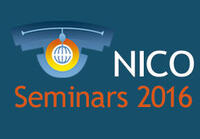Friday, 17th June - h 14:00
Seminars room, NICO
SEL1L: a molecular biological clock in neuronal differentiation
Ida Biunno
Senior researcher at CNR - Italian National Research Council
Univesity of Chieti (Italy) - Biotechnology Center of Temple University Philadelphia-USA
SEL1L (Suppressor/Enhancer of Lin-12-like) is a member of the ubiquitin-ligase complex involved in the Endoplasmic Reticulum Associated Degradation (ERAD) pathway. Homozygous mutant mice for SEL1L are embryonic lethal, displaying altered organogenesis and increased apoptosis in the forebrain and in the dorsal ganglions (1). mSEL1L was found to be highly expressed in mouse embryonic stem cells (mESC) and during neural commitment but silenced during differentiation (2).
While is ubiquitously expressed in the early stages of embryonic mice brain, in adult brain decreased to the point that only SOX2 rare cells, localized in the neurogenic niches, retain the protein. In canine ataxia, SEL1L was proposed as a candidate gene in progressive childhood ataxias (3). To further investigate the early stages of embryonic development and the correlation between SEL1L and neural stemness, we decided to adopt the zebrafish (D. Rerio) as animal model system.
Data obtained so far show that sel1l mRNA is both maternally and zygotically expressed, providing its importance in embryo development, the results support the mouse model. Whole mount in situ hybridizations (WISH) revealed the expression of sel1l mRNA in different districts of the embryo. In particular, at 24 hours post fertilization (hpf) sel1l signal is restricted to the brain areas, the gut and pectoral fin buds; at 72 hpf, brain, retina and liver bud signals can be identified. Gene knockdown by morpholino injection revealed several development disorders among which brain necrosis, head dysmorphisms, altered blood circulation an heart related defects. WISH performed with neural markers are currently ongoing to determine brain regions and pathways affected by sel1l knockdown.
(1) Francisco AB et al., Jo. Biol Chem. 2010; 285:13694
(2) Cardano M., et al., Jo. Biol Chem.2011; 286:18708
(3) Kyostilia K., et al., Plos Genetics 2012 e1002759
Host: Annalisa Buffo








